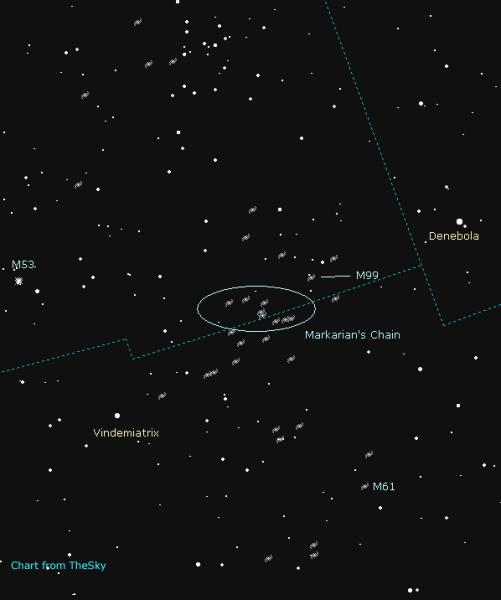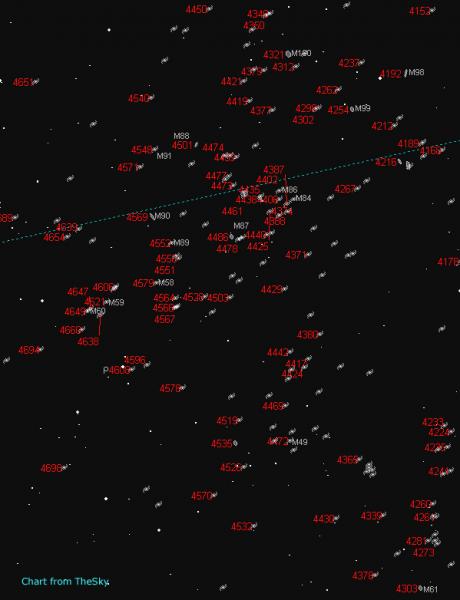More Galaxies and A Daytime Planet
Continuing on the theme of last month’s article that dealt with the overwhelming number of galaxies available to small and moderate size telescopes, we will now look at a few remote objects in the Constellation Virgo. First, locate the star Denebola – the end star of the Leo the Lion. Proceed to move about eleven degrees east and a bit south until you arrive at the coordinates; right ascension (RA) 12 hours 28 minutes and declination (Dec) +12 degrees 13 minutes. Your telescope is now at the somewhat heart of a vast swarm of a hundred or so remote galaxies down to 14th magnitude. The entire group of galaxies measures about 12 degrees in height and 8 degrees in width. A usual method of locating a particular galaxy is to visually star hop till you reach your target. The tricky part about the Virgo cluster in some cases is the lack of guide stars. To locate a particular object, you will have sometimes, galaxy hop.
One of my favourite regions of the Virgo cluster is the duo of M84 and M86. Both galaxies are listed as one of the brightest members of the cluster and shows as a nice pair in a wide-angle eyepiece. M84 is classified as an E1 elliptical galaxy that glows at magnitude 9.1. M86 is another featureless elliptical but slightly elongated with a designation of E3. Both objects residing some 60 million light-years from us. M84 and 86 also form the rightmost end of Markarian’s Chain of galaxies. Just as the name suggests, it is a line of eight galaxies stretching from NGC 4458 and ending at M84. This cosmic lineup takes up one and a half degrees of sky or three full moons placed side by side. Other smaller galaxies dot the area below the Chain.

Retreat back west about a quarter of the way to Denebola and a bit north till you happen upon M99 which actually lies across the border in Coma Berenices. This is a lovely face-on spiral galaxy that lies in the same 60 million light-year range. You should be able to make out its extended arms. M99 had some drama in its quite recent past with two type II supernovas in 1967 and again in 1972 as well as a type I in 1986. Just over a degree, NW of M99 is M98. Here we see a near edge-on orientation. This spiral, just like the others lies roughly the same distance from us. At magnitude 10.1 M98 is long and thin, measuring 9.5 arc minutes in length and 3.2 arcmins in width. Before leaving the area you must hunt down a fantastic pair of contrasting galaxies. Located three-quarters of a degree to the east of M99 is NGC 4298 and 4302.
Our next target is in the southern extreme of the Virgo cluster. M61 is another face-on barred spiral galaxy with a good amount of arm structure. M61 is just under 10th magnitude and at 100,000 light-years in length (same as our Milky Way Galaxy) making it one of the largest galaxies in the Virgo cluster. Astronomers believe high-velocity gas is moving in the galaxy’s halo. At the time of its discovery in 1779, one observer mistook M61 as a comet. For a nice change of pace with something much closer and brighter to observe, locate M53 in Coma Berenices. This highly resolved globular cluster is estimated to be around 220 light-years wide and some 60,000 light-years from us. M53 is catalogued at magnitude 7.6 and is almost half a full moon wide.

Now that Jupiter has all but disappeared from view into the solar glare, Venus is still taking centre stage. Because the planet is moving between Earth and the Sun, Venus is taking on some dramatic phase structure much like the moon as it comes out of new phase. Venus now sports a 29% lit crescent on May 1st and is fantastic when viewed through a telescope. In fact, if you have a computerized telescope, you should be able to observe it during the day. A few years ago while at the General Assembly in Kelowna, BC, I was fortunate to catch it naked eye. The Sun was still three hours from setting but the very transparent sky took on a deep blue. That is a sight I will never forget.
The red planet Mars is well-placed overhead at sunset but over the next few months, its small disk will keep shrinking as our two worlds drift away from each other. Because of orbital elements, Mars and Earth have a close encounter every 25 months with every 7th close approach being the best. The red planet’s next couple of visits will occur on April 8, 2014, May 22, 2016, with the best visit since the 2003 encounter will occur on July 27, 2018. We should see lots of planetary detail as it will be doubled its current apparent size than what we see now.
With local public star parties now underway, the showpiece of the night belongs to Saturn. Many first time viewers peering through the eyepiece of a telescope cannot believe what they are seeing. It is almost comical to hear first impressions as their eyes gaze at the lovely rings. Saturn’s ring system will continue to open for another five years until 2017.
The Full Flower Moon will occur on May 5th at 23:35 EDT. As well the super moon will also be at its closest to Earth (perigee) and largest in 2012 and with a distance of 357,190 km, very high tides are expected. As luck would have it, this is the same night as the Eta-Aquarid meteor shower. Sparked by the passage of Halley’s Comet in 1986, the peak of one meteor per minute takes place in the afternoon at 15:00
The new moon (lunation 1106) takes place on the 20th at 19:47 EDT. It just so happens the moon will also be at its farthest point from us (apogee) at 401,167 km. There will also be annular eclipse for those living on a path from central Texas to Northern California. With the Moon being so far from Earth, 99% of the Sun will be blocked. The eclipse continues across the Pacific and onto Asia. However western Canada and the USA will see a partial event to some extent. Here in Ottawa, the eclipse begins just before the 20:31
Until next month, clear skies everyone.
